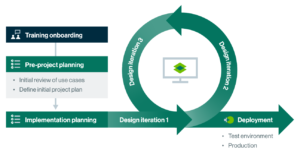So your team has identified implementing data governance as a priority for the year. You’ve read analyst reports and whitepapers. You’ve attended conferences and webinars. You’ve evaluated and demoed countless technologies and you think you’re ready to select a solution.
But what happens once you purchase a data governance platform? Do you deploy the technology and POOF! all your data problems are solved? Not exactly. This article is meant to outline the vital steps for implementing data governance.
Why a data governance roadmap is vital
Data teams need to build a roadmap for their organizations to follow in order to successfully implement data governance. There is so much focus on the importance of data governance and the value it brings, but very little emphasis is given to how it’s done. Of course the why is important, but the how should receive just as much weight and in most cases, the how is the more complex part. At Collibra, we recommend a 10-step approach to data governance.
10 steps to successful data governance
- Governance foundation: An organization must first establish a governance foundation by establishing the company’s priorities, the organizational structure, roles, guiding principles, and roadmap.
- Prioritize: Establish tier 1 critical KPIs or use cases to prioritize data, resources, calculations and scope.
- Define: Implement a business term glossary for prioritized key business domains. Also include identification of stakeholders, definition/approval and issue management processes.
- Link: Ingest system metadata and link it to the business terms and KPI’s.
- Quality: Establish requirements for fit-for-purpose data for consumers, including quality checks, thresholds, and a help desk resolution process.
- Publish: Publish governed data to consumers. Establish communications, and deliver education to consumers to find, utilize, and trust data.
- Report and calculation stewardship: Working groups define reports, computational models, calculations, frequency, processes, API’s and assumptions for calculating the derived values used for key metrics and reporting.
- Data sharing agreements: Establish request and approval processes for internal and external data sharing and usage. Ensure usage meets the agreements and policies.
- Program metric certification: Establish automated metric processes for the prioritized program metrics. Refine program level dashboards and scorecards to report program level metrics.
- Reporting value: Measure and report progress and value. Re-plan and revise strategy and roadmap. Plan detail roadmap changes and re-iterate steps 2-8 for each iteration.
Components of your data governance strategy
When building a data governance strategy with your team of cross functional partners, you must include some crucial components in your plan:
- Data governance program statement and objectives
- Prioritized list of business use cases aligned to business projects. Benefits and risks may be defined for each use case. If you need a cost justification exercise, it should be done outside of the strategy so as not to delay the development of the strategy.
- Governance implementation roadmap based upon the business use cases and infrastructure requirements such as education should also be identified.
- The framework of a proposed data governance organization, as well as roles and responsibilities.
- An estimate of funding expectations for the activities in the roadmap.
- A communications plan and educational expectations will help establish the resources that need to be involved. Detailed process definition and technology education should be a roadmap step.
We recommend that you include statements about why data quality and data controls will be included within the scope of the data governance program. Additionally, be sure to include statements about why data quality fit-for-purpose metrics will be managed in a consistent manner through the data governance program.
Keep the strategy statements at the why and who levels. You should also include statements about why data privacy, data security, data retention, and data disposal will be monitored within the data governance strategy. While other organizations may define the policies for those, the operational activities identified in those policies will be communicated, monitored and measured for compliance by the data governance program.
And finally, identify the strategy you anticipate to measure progress, metrics and maturity of the information governance program.
How to avoid an implementation failure

As you build your implementation roadmap, it’s important to keep these three things in mind:
- Be use case driven: Don’t implement data governance just for the sake of saying you have a data governance practice. Your data governance program needs to add value. Identify a use case to tackle data governance to keep your plan focused during early stages.
- Iterate: Your first attempt at building a framework likely will not be the winning design. Don’t be afraid to evaluate your plan and make changes as needed.
- Get support: You don’t have to be the expert at everything. Too many data teams try to handle everything themselves, but data governance is a hefty task. Engage other parts of the business and consult trusted advisors, industry peers and vendors for support.




